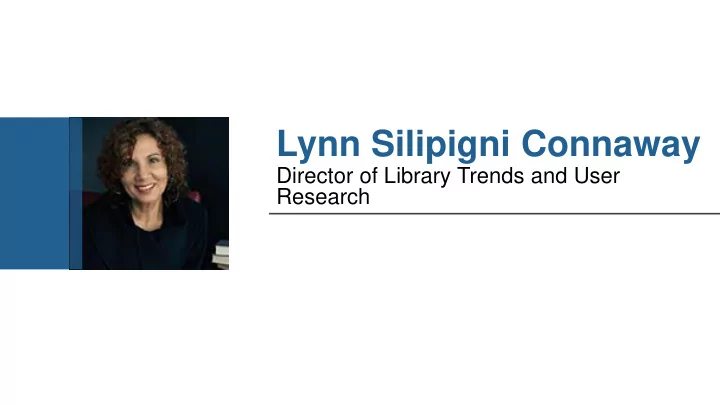

Lynn Silipigni Connaway Director of Library Trends and User Research
Researching Students’ Information Choices (RSIC): Determining Identity and Judging Credibility in Digital Spaces • 4-year IMLS funded National Leadership Grant #LG-81-15-0155 • Research questions: • Do STEM students differentiate among different types of digital resources at point of selection? • How do STEM students determine the credibility of digital resources? http://guides.uflib.ufl.edu/RSIC
RSIC RESEARCH TEAM Ixchel Faniel, PhD Co-Principal Investigator Lynn Silipigni Connaway, PhD Co-Principal Investigator Amy Buhler, MSLS Tara Cataldo, MLS Erin Hood, MLIS Erin Hood, MLIS Principal Investigator Co-Principal Investigator Investigator Investigator Brittany Brannon Brittany Brannon, MA Samuel Putnam, MLS Research Assistant Research Assistant Investigator Rachael Elrod, M.Ed., MSLS Investigator Randy Graff, PhD Investigator Joyce Valenza, PhD Joyce Valenza, Ph.D. Summer Howland Co-Principal Investigator Co-Principal Investigator Simulation Designer Kailey Langer Research Assistant
RSIC ADVISORY PANEL Adam Fournier 6 th Grade Science Teacher Alix Freck Public Librarian Matthew Carrigan Megan Sorenson College Professor Elementary School Emilio Bruna Science Lab Teacher Jennifer Kuntz University Professor School Librarian Jenna Miller College Librarian Gayle Evans Science Master’s Teacher
“Google Generation are format agnostic and have little interest in the containers (reports, book chapters, encyclopedia entries)… we feel this one is still wide open . It is a hugely important issue for libraries and publishers” (Williams & Rowlands, 2007, p. 20)
Container Collapse (#containercollapse) • Visual context and cues that print containers provide used to help individuals identify a document’s origins and measure its value • Cues are obscured or more difficult to discern • “In digital format, a document is decanted from its original container and must be carefully examined to determine the journey it took to reach the individual.” (Connaway et al., 2018)
Methods
Research Methods Participants - Alachua Data Collection County, FL • Pre-screen survey 4 th – 5 th grade • • Simulation 6 th – 8 th grade • • Pre-interview 9 th – 12 th grade • • Information Choice Tasks • Community college • Post-Interview • University undergraduate • University graduate
Simulation tasks 1. Useful task – select 20 useful sources 2. Cite task – would you cite your useful sources? 3. Why Not Useful task – why weren’t they useful? 4. Credibility task – how credible are these resources? 5. Container tagging – what container best describes these 20 resources?
CITE? CHOOS E IDENTIFY - Container EVALUATE - Credibility
Simulation data being collected • Quantitative data from Storyline • Choices made in each task • Every click into a resource • Qualitative data • Pre and Post interview questions • Audio transcript • Video file – attempted clicks or points not captured by Storyline
Resources Container Adult 9-12 6-8 4-5 Blog 5 4 2 1 Book 7 5 3 3 Conference Proceedings 2 0 0 0 Magazine 3 6 4 4 Journal 8 4 3 2 News 4 5 5 1 Preprint 2 1 0 0 Website 9 15 13 9 Total 40 40 30 20
High-Level Findings
Container Collapse • Students believe – important to know the container from which online information comes • number decreases with younger students – in own abilities to discern sources • only 2% of participants express limited confidence in their ability to select online resources for research projects (Connaway et al., 2018)
Student Perspectives • “What’s a preprint?” • “I don’t really know if New York Times is a journal or a magazine.” • “I know this is a blog because it’s by a person that wrote it.” • “This is a journal … because of the feel of it looking like a scholarly article.” • “This one’s a blog. Or is it a journal. Or is it a book? It’s a journal.” • “This shouldn’t be so hard.”
Pilot Results
Adult Pilot Pilot ≠ Findings Pilot was to help prepare for the actual participants. Adult pilot studies were conducted with 6 participants • 2 community college students • 2 undergraduate students • 2 graduate students
Adult Pilot Container Task Community College Undergraduate Graduate 0 5 10 15 20 25 30 35 Correct Answers
Adult Pilot Most agreement: Least agreement: • The New York Times • USGS.gov news (journal, • Springer journal website, news, preprint) • Wiley journal • USGS.gov book (journal, • Google book book, website) • Royal Society Publishing (conference proceeding, journal, preprint)
Adult Pilot
Adult Pilot
Adult Pilot On Wikipedia: “Nobody really cares enough about science sources to make them wrong.”
Why is it important to know the container? “It's important, but does not differentiate a ton between types.” “Blogs people ranting, news all over the place, don't know who to trust.” “Blog is opinion. Article may have some opinion.” “Helps you determine whether or not it is from a credible source. Blogs are opinions.” “All have a different way of framing information - even peer reviewed journals have a spin, but at least they need to cite where the info came from.” “It is very important to know if from a book or journal instead of a blog. It is important because the source has to be reputable.”
Potential Impact • Help develop curriculum • Information literacy • Digital literacy • Citation styles • Inform design of digital information • Emphasize need to instruct sooner • Emphasize need for consistent instruction
References Buhler, A., & Cataldo, T. (2016). Identifying E-Resources: An Exploratory Study of University Students. Library Resources & Technical Services, 60(1), 23-37. https://journals.ala.org/index.php/lrts/article/view/5899 Connaway, L. S., Buhler, A., Cataldo, T., Faniel, I., Valenza, J., Elrod, R., Graff, R., Putnam, S., Brannon, B., Hood, E., Fowler, R., Langer, K., Kirlew, S. (2018). What is “container collapse” and why should librarians and teachers care? OCLC Next. http://www.oclc.org/blog/main/what-is-container-collapse-and-why-should- librarians-and-teachers-care/. Williams, P., & Rowlands, I. (2007). Information Behaviour of the Researcher of the Future: The Literature on Young People and Their Information Behaviour. British Library/JISC. Retrieved from http://www.jisc.ac.uk/media/documents/programmes/reppres/ggworkpackageii.pd f
Recommend
More recommend